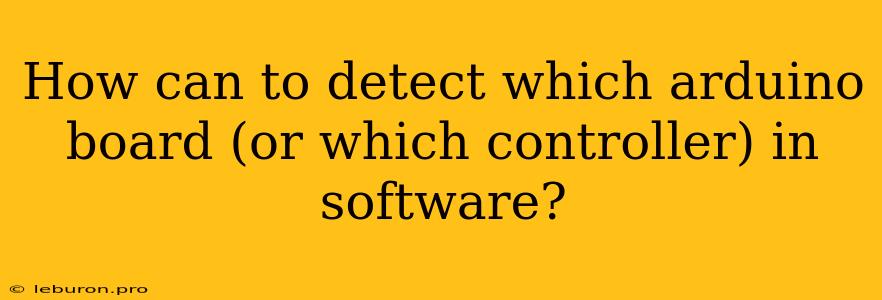Determining Your Arduino Board in Software: A Comprehensive Guide
Identifying the specific Arduino board you're working with within your software is crucial for various reasons. Whether you're using a library tailored to a particular board, need to adjust code for hardware compatibility, or simply want to ensure you're targeting the correct device, knowing the board type is essential. This guide will walk you through different techniques and resources to effectively detect your Arduino board in software.
Utilizing the Arduino IDE
The Arduino IDE provides a simple and straightforward way to identify your board. When you open the IDE, you'll see a dropdown menu in the top-right corner labelled "Tools." This menu contains a list of available Arduino board types, allowing you to select the one you are currently using. The selected board type will be used by the IDE when compiling and uploading your sketches.
1. Selecting the Correct Board Type:
- Open the Arduino IDE and navigate to the "Tools" menu.
- Choose the "Board" option from the submenu.
- You'll see a list of various Arduino boards, including common options like Arduino Uno, Arduino Mega, Arduino Nano, and Arduino Leonardo.
- Select the board that matches your hardware.
2. Checking the Board's Identifier:
- Once you have selected your board, go to the "Tools" menu again and choose "Board Identifier."
- This will display a code that identifies the specific board type. This code is useful if you need to reference the board in your sketch or if you're working with external libraries that require a specific board identifier.
Leveraging the Arduino Language
For more programmatic control over board identification, you can use the Arduino language itself. The Arduino.h header file provides several functions and constants that allow you to retrieve information about your board and its capabilities.
1. Identifying the Processor Architecture:
- The
F_CPUmacro provides the clock frequency of the processor, a helpful indicator for your board. For instance, the Arduino Uno uses a 16 MHz clock, while the Arduino Mega uses a 16 MHz clock. - The
ARDUINOconstant defines the board type and can be used in conditional statements to execute code specific to certain boards.
#if defined(ARDUINO_AVR_UNO)
// Code for Arduino Uno
#elif defined(ARDUINO_AVR_MEGA2560)
// Code for Arduino Mega
#endif
2. Using Board-Specific Functions:
- The Arduino language offers functions like
analogReadResolution(),digitalPinToInterrupt(), andtone()which may have varying implementations depending on the board type. Utilizing these functions can indirectly indicate the board you're using if the results differ across different models.
External Libraries for Advanced Board Identification
While the Arduino IDE and basic language features provide a solid foundation, you can further enhance your board detection capabilities using external libraries. These libraries often offer more granular information and sophisticated methods for identifying your hardware.
1. ArduinoBoardDetect:
- This library offers a convenient way to detect different Arduino boards within your sketch. It analyzes the board's unique identifiers, allowing you to retrieve information such as the board name, processor type, and memory size.
2. Arduino Hardware:
- This library provides access to the Arduino's underlying hardware, including the processor, memory, and peripherals. By interrogating these hardware elements, you can determine the specifics of your board.
3. Board Manager:
- The Arduino IDE's Board Manager allows you to install and manage different boards. If you're using a board not listed in the default selection, you can install the corresponding board package via the Board Manager. This ensures that the IDE recognizes your custom board.
Conclusion
Identifying the specific Arduino board you're working with in software is crucial for successful development. The Arduino IDE provides a convenient user interface for selecting your board, while the Arduino language offers functions and macros to programmatically determine the board type. External libraries offer advanced options for identifying hardware details and customizing your development workflow. By utilizing these techniques and resources, you can confidently ensure your code interacts effectively with your chosen Arduino board.
